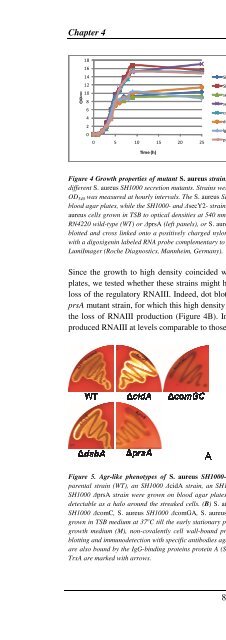The Staphylococcus aureus secretome - TI Pharma
The Staphylococcus aureus secretome - TI Pharma
The Staphylococcus aureus secretome - TI Pharma
Create successful ePaper yourself
Turn your PDF publications into a flip-book with our unique Google optimized e-Paper software.
Chapter 4<br />
D<br />
O<br />
540<br />
18<br />
16<br />
14<br />
12<br />
10<br />
8<br />
6<br />
4<br />
2<br />
0<br />
0 5 10 15 20 25<br />
Time (h)<br />
SH1000+<br />
SH1000-<br />
secY2+<br />
secY2-<br />
comGA<br />
dsbA<br />
lgt<br />
prsA<br />
Figure 4 Growth properties of mutant S. <strong>aureus</strong> strains and RNAIII production. (A) Growth curves of several<br />
different S. <strong>aureus</strong> SH1000 secretion mutants. Strains were grown in TSB at 37 o C under vigorous shaking and the<br />
OD 540 was measured at hourly intervals. <strong>The</strong> S. <strong>aureus</strong> SH1000+ and ∆secY2+ strains show hemolysin activity on<br />
blood agar plates, while the SH1000- and ∆secY2- strains do not show this feature. (B) RNA was prepared from S.<br />
<strong>aureus</strong> cells grown in TSB to optical densities at 540 nm of 1, 10 or 15. Serial dilutions of total RNA of S. <strong>aureus</strong><br />
RN4220 wild-type (WT) or ∆prsA (left panels), or S. <strong>aureus</strong> SH1000 wild-type (WT) or ∆prsA (right panels) were<br />
blotted and cross linked onto a positively charged nylon membrane. <strong>The</strong> membrane-bound RNA was hybridized<br />
with a digoxigenin labeled RNA probe complementary to RNAIII. Chemiluminescence signals were detected with a<br />
LumiImager (Roche Diagnostics, Mannheim, Germany).<br />
Since the growth to high density coincided with a non-hemolytic phenotype on blood agar<br />
plates, we tested whether these strains might have accumulated agr mutations, leading to the<br />
loss of the regulatory RNAIII. Indeed, dot blot analyses performed for the S. <strong>aureus</strong> SH1000<br />
prsA mutant strain, for which this high density growth phenotype was first observed, revealed<br />
the loss of RNAIII production (Figure 4B). In contrast, the S. <strong>aureus</strong> RN4220 prsA mutant<br />
produced RNAIII at levels comparable to those of the parental strain (Figure 4B).<br />
Figure 5. Agr-like phenotypes of S. <strong>aureus</strong> SH1000-derived secretion mutants. (A) <strong>The</strong> S. <strong>aureus</strong> SH1000<br />
parental strain (WT), an SH1000 ∆cidA strain, an SH1000 ∆comGC strain, an SH1000 ∆dsbA strain, and an<br />
SH1000 ∆prsA strain were grown on blood agar plates and incubated overnight at 37ºC. Hemolytic activity is<br />
detectable as a halo around the streaked cells. (B) S. <strong>aureus</strong> SH1000 (WT), S. <strong>aureus</strong> SH1000 ∆cidA, S. <strong>aureus</strong><br />
SH1000 ∆comC, S. <strong>aureus</strong> SH1000 ∆comGA, S. <strong>aureus</strong> SH1000 ∆comGC, and S. <strong>aureus</strong> SH1000 ∆dsbA were<br />
grown in TSB medium at 37 o C till the early stationary phase. Samples of extracellular proteins isolated from the<br />
growth medium (M), non-covalently cell wall-bound proteins (CW) and total cells (C) were used for Western<br />
blotting and immunodetection with specific antibodies against TrxA or SspB. Note that the antibodies against TrxA<br />
are also bound by the IgG-binding proteins protein A (Spa) and Sbi. Bands corresponding to Spa, Sbi, SspB and<br />
TrxA are marked with arrows.<br />
84













